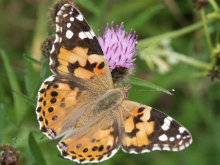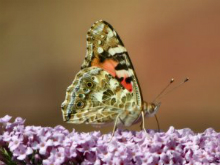

Painted LadyVanessa carduiVariable migrant 
Distribution and Status The Painted Lady is a regular summer visitor to our branch area but its numbers fluctuate widely each year. Adults originate from north Africa and some theories have been suggested on what triggers migration. In spring, weather in north Africa is probably too hot and dry for the butterfly to survive without healthy hostplants to breed and flowers to feed on. A reverse southward migration in the autumn also occurs but the butterflies mostly fly at much higher altitudes so far fewer sightings of this event are recorded. The best years in the two counties since the 1980s were 1996, 2003, 2006, 2009 and 2019. A huge invasion occurred over the Spring Bank Holiday in 2009 but transect counts do not reflect the large numbers because the migration lasted only a few days at any particular place Habitat Requirements Being a mobile species it can be seen in every habitat type but it is perhaps most abundant in fields where there are thistles. Not only are thistles the main larval foodplants but also good nectar sources Larval Foodplants Thistle Carduus spp. and Cirsium spp. Musk Thistle Carduus nutans is probably the favoured plant on dry calcareous soils. Stinging Nettle Urtica dioica, Mallow Malva spp., Burdock Arctium spp. and Viper's Bugloss Echium vulgare are other foodplants sometimes selected Adult Food Sources Buddleia Buddleja davidii, Red Valerian Centranthus ruber, Iceplant Sedum spectabile Behaviour/Observation notes The best time to look for the Painted Lady is in August in gardens and waste ground where thistles are in flower. In the spring, look for it feeding on willow flowers 
Life History The Painted Lady usually starts arriving here in April, with several generations produced throughout the summer augmented by more immigrants from the continent. In September and October, some individuals may be observed emigrating in a southerly direction. Eggs are laid singly on the foodplant often on the leaf upperside. Larvae hatch out usually after about a week and form silk tents under the leaves. Pupae are formed within these tents Further information
Photo gallery |